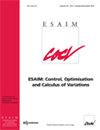准线性双曲平衡律的饱和边界反馈控制及其在轻水车交通流稳定中的应用
IF 1.2
3区 数学
Q4 AUTOMATION & CONTROL SYSTEMS
Esaim-Control Optimisation and Calculus of Variations
Pub Date : 2023-01-01
DOI:10.1051/cocv/2023070
引用次数: 0
摘要
本文研究了一类具有平衡律的拟线性双曲型系统在H -范数下的饱和边界稳定问题,该系统的边界条件受致动器饱和的约束。所得到的闭环系统在饱和状态下相对于稳态是局部指数稳定的。为此,引入扇形非线性模型来处理饱和项,然后利用Lyapunov函数方法和扇形条件,从一组矩阵不等式的角度建立了保证局部指数稳定性的充分条件。并将这些结果应用于以lighhill - whitham - richards (LWR)模型为代表的双车道交通流动态稳定化问题。利用可变限速(VSL)装置,设计了一种饱和边界反馈控制器来稳定双车道交通流,并通过数值仿真验证了拟线性交通流系统在h2意义下的指数收敛性。本文章由计算机程序翻译,如有差异,请以英文原文为准。
Saturated boundary feedback control of quasi-linear hyperbolic balance laws with application to LWR traffic flow stabilization
The saturated boundary stabilization problem for quasi-linear hyperbolic systems of balance laws is considered under H 2 -norm in this paper, where the boundary conditions of the system are subject to actuator saturations. The resulting closed-loop system is proven to be locally exponentially stable with respect to the steady states in the presence of saturations. To this end, the sector nonlinearity model is introduced to deal with the saturation term, and then sufficient conditions for ensuring the locally exponential stability are established in terms of a set of matrix inequalities by employing the Lyapunov function method along with a sector condition. Furthermore, these results are applied to the stabilization of the two-lane traffic flow dynamic represented by Lighthill–Whitham–Richards (LWR) model. By utilizing variable speed limit (VSL) devices, a saturated boundary feedback controller is designed to stabilize the two-lane traffic flow, and the exponential convergence of the quasi-linear traffic flow system in H 2 sense is validated by numerical simulations.
求助全文
通过发布文献求助,成功后即可免费获取论文全文。
去求助
来源期刊

Esaim-Control Optimisation and Calculus of Variations
Mathematics-Computational Mathematics
自引率
7.10%
发文量
77
期刊介绍:
ESAIM: COCV strives to publish rapidly and efficiently papers and surveys in the areas of Control, Optimisation and Calculus of Variations.
Articles may be theoretical, computational, or both, and they will cover contemporary subjects with impact in forefront technology, biosciences, materials science, computer vision, continuum physics, decision sciences and other allied disciplines.
Targeted topics include:
in control: modeling, controllability, optimal control, stabilization, control design, hybrid control, robustness analysis, numerical and computational methods for control, stochastic or deterministic, continuous or discrete control systems, finite-dimensional or infinite-dimensional control systems, geometric control, quantum control, game theory;
in optimisation: mathematical programming, large scale systems, stochastic optimisation, combinatorial optimisation, shape optimisation, convex or nonsmooth optimisation, inverse problems, interior point methods, duality methods, numerical methods, convergence and complexity, global optimisation, optimisation and dynamical systems, optimal transport, machine learning, image or signal analysis;
in calculus of variations: variational methods for differential equations and Hamiltonian systems, variational inequalities; semicontinuity and convergence, existence and regularity of minimizers and critical points of functionals, relaxation; geometric problems and the use and development of geometric measure theory tools; problems involving randomness; viscosity solutions; numerical methods; homogenization, multiscale and singular perturbation problems.
 求助内容:
求助内容: 应助结果提醒方式:
应助结果提醒方式:


